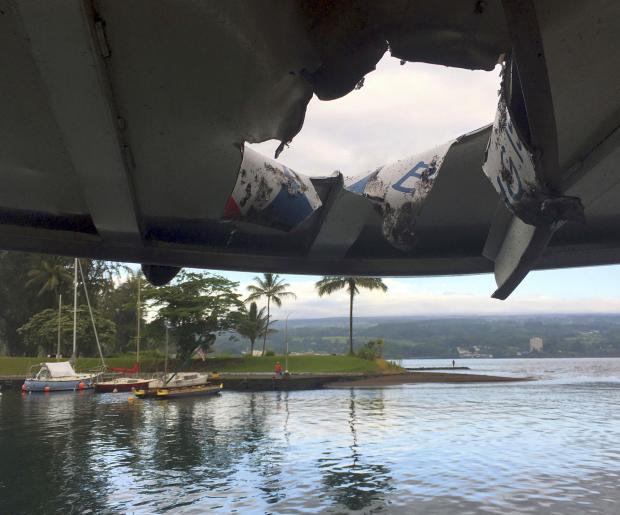Hawaii volcano boat tours continue after lava injuries

This photo provided by the Hawaii Department of Land and Natural Resources shows damage to the roof of a tour boat after an explosion sent lava flying through the roof off the Big Island of Hawaii Monday, July 16, 2018, injuring at least 23 people. The lava came from the Kilauea volcano, which has been erupting from a rural residential area since early May. (Photo from the Hawaii Department of Land and Natural Resources via AP)
HONOLULU — Hawaii tour boat operators plan to continue taking visitors to see lava, but will follow the Coast Guard’s revised policy and stay farther away after an explosion caused molten rock to barrel through the roof of a vessel, injuring 23 people.
The Coast Guard prohibits vessels from getting closer than 984 feet (300 meters) from where Kilauea volcano’s lava oozes into the sea. The agency had been allowing experienced boat operators to apply for a special license to get closer up to 164 feet (50 meters), but it stopped allowing those exceptions Monday morning.
A woman in her 20s was transported to Honolulu in serious condition with a broken thigh bone. The other 22 people injured were treated for minor burns and scrapes, including 12 who were treated at a hospital in Hilo.
Moku Nui Lava Tours Captain Kanoa Jones, whose boat was not involved in Monday’s incident at Kilauea volcano, said not running the tours would only withhold income from local restaurants and other businesses dependent on tourism, he said.
“If we stop operating, it not only hurts us, it hurts the community,” Jones said.
Article continues after this advertisementThe Coast Guard, state and local officials were investigating what happened.
Article continues after this advertisementCoast Guard spokesman Petty Officer 3rd Class Matthew West said the agency can’t say whether it will change its safety zone rules until it finishes its investigation.
The county strictly limits access to the lava on land for safety reasons, making boat and helicopter tours the only options people have to witness volcanic spectacle in person. The ocean and aerial tours each cost about $250.
The restrictions have deterred many travelers from visiting the Big Island in general, and Puna near the volcano in particular.
Shane Turpin, the owner and captain of the vessel that was hit, said he never saw the explosion.
He and his tour group had been in the area for about 20 minutes making passes of the ocean entry about 500 yards — which is the length of five football fields – offshore, Turpin said.
He didn’t observe “any major explosions,” so he navigated his vessel closer, to about 250 yards (228 meters) away from the lava.
“As we were exiting the zone, all of a sudden everything around us exploded,” he said. “It was everywhere.”
The US Geological Survey says explosions of varying sizes occur whenever 2,000-degree (1,093-degree Celsius) lava enters much colder seawater.
Monday’s large blast may have been amplified by the relatively shallow water at the point where the lava entered the sea. That’s because explosions occur much closer to the surface in such spots.
In contrast, lava that entered the ocean in 2016 hit a steep slope and quickly fell to deeper parts of the sea, said Janet Babb, a geologist with the US Geological Survey.
The volcano has also been pumping more lava into the water now compared to past years, Babb said. Kilauea is sending to the sea as much as 26 times the amount of lava per second than it did during the 2016-17 eruption.
Officials have warned of the danger of getting close to lava entering the ocean, saying the interaction can create clouds of acid and fine glass. Despite the hazards, several companies operate such tours. The Coast Guard said tour vessels have operated in the area going back at least 20 years.
The molten rock is coming from the Kilauea volcano, which has been erupting continuously for the past 35 years.
In May, its eruption entered a new phase when it began spurting lava through newly formed fissures in a residential neighborhood. It has destroyed more than 700 homes since then.
But the only serious injury over the past two months was to a man who was hit by flying lava that broke his leg.
Captain Jones said an evening boat tour left for the ocean-entry site and it was business as usual.
“It is Mother Nature,” Jones said. “You never know.”